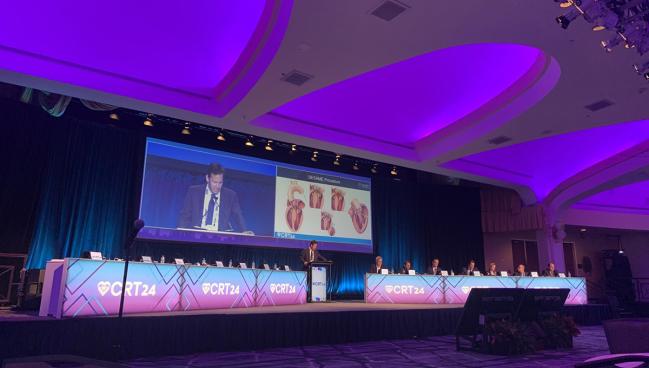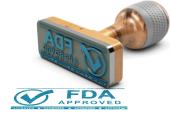Open SESAME? Transcatheter Myotomy Shows Promise for LVOT Obstruction
The transcatheter electrosurgical procedure mimics surgical myotomy and carries significant risks, but there’s an unmet need.

WASHINGTON, DC—A transcatheter electrosurgical procedure that mimics surgical myotomy may be an option in some patients to relieve left ventricular outflow tract (LVOT) obstruction in the setting of hypertrophic cardiomyopathy, or to create space for transcatheter mitral valve replacement (TMVR), the SESAME trial suggests.
Aside from surgical myotomy, one nonsurgical option in these patients is alcohol septal ablation. However, that option carries risks such as geographic miss, replacement fibrosis that can increase the likelihood of later arrhythmias, and potential need for pacemaker implantation, noted Vasilis C. Babaliaros, MD (Emory University Hospital, Atlanta, GA), in his presentation here at CRT 2024. The results were simultaneously published in the Journal of the American College of Cardiology.
Babaliaros and colleagues developed the transcatheter solution on a compassionate use basis for patients who need septal reduction therapy with myocardial laceration. This trial represents the first-in-human clinical experience.
The SESAME procedure involves advancing catheters retrograde across the aortic valve and applying radiofrequency energy to lacerate the myocardium and create a myotomy trough. Over time, the myotomy splays and enlarges the LVOT.
“There's a steep learning curve and the technique still requires refinement,” Babaliaros noted. “If you've seen these live cases, it's usually two operators in a biplane lab yelling at the imager back and forth. But we believe with purpose-built, designed devices that we could do this in a single plane, single operator, with less dependance on a supernatural echocardiographer.”
According to Babaliaros, the complications seen in the single-center trial were comparable to contemporary reports of septal reduction therapy for hypertrophic cardiomyopathy, and better than reports of septal reduction to facilitate TMVR.
“There’s definitely a need for this procedure,” Philippe Généreux, MD (Morristown Medical Center, NJ), one of the session’s panel discussants, told TCTMD. “Obviously, it’s a very challenging procedure. It could also be a dangerous procedure, [but] these investigators have made a lot of progress and I strongly believe that with increased knowledge, and increased learning of this technique, they will show even more improvement in the future.”
As Babaliaros explained, five patients experienced iatrogenic myocardial perforation during the procedure and two patients undergoing the SESAME procedure to create space for TMVR died. Still, he said patients are fully informed of the risks and often are of the mindset that they want a less invasive procedure with the lowest risk of pacemaker.
SESAME Results
For the single-center study, Babaliaros and colleagues led by Adam Greenbaum, MD (Emory University Hospital), enrolled 76 patients (mean age 77 years; 82% women). The majority of patients (n = 65) required space for TMVR, and the other 11 patients had hypertrophic cardiomyopathy. While most of the procedures were done electively, Babaliaros said about 18% of the cohort was treated emergently, including some patients treated with left ventricular assist devices.
Myocardial engagement and laceration was successful in all 76 procedures. The mean procedure time was 174 minutes, although the investigators found that they were able to shorten the time as they gained experience.
In four patients, electrosurgical myocardial laceration induced ventricular arrhythmia, with only two of those patients requiring defibrillation. In addition to the perforation injuries and two deaths, 30% of patients had a major procedural complication, with 20% having major or life-threatening bleeding. Approximately one-quarter of patients experienced MACE in the 30 days after the procedure.
There's a steep learning curve and the technique still requires refinement. Vasilis C. Babaliaros
Septal thickness was reduced by approximately 50% in all patients, from a mean of 16.4 mm to 8.5 mm (P < 0.001).
In those with hypertrophic cardiomyopathy, invasive LVOT gradients both resting and provoked were reduced (P = 0.023) and (P = 0.076), respectively. In that group, no pacemaker placement was needed. Similarly, in those needing space to allow TMVR, measures to predict post-TMVR improved (P < 0.001).
Challenges and Realities of Risk
According to Babaliaros, the imaging of these procedures is quite challenging and the reason why a dedicated device is needed.
For Généreux, the innovation that these investigators are doing is anticipated to trickle down to operators who need an easier way to treat these patients. “Every month I see a patient who needs this, we will send to surgery or treat medically, and some have no options. But, if this procedure becomes a little bit more simplified, more reproducible, and maybe safer, it is definitely something I will be doing,” he said.
Addressing the risk, Généreux added that for many of his patients who are similar to those in SESAME, their quality of life is terrible and their survival is uncertain. Many don’t qualify for surgery or don’t respond to available medical therapy.
“Even knowing that the mortality could be as high as 5%, or between 2% and 5%, based on these data, that’s not far off from other high-risk surgery,” he said. “This is obviously not a mainstream procedure. It requires a lot of skill and knowledge, [but] there is a clear unmet need in these patients who deserve a treatment to improve their quality of life and their survival.”
L.A. McKeown is a Senior Medical Journalist for TCTMD, the Section Editor of CV Team Forum, and Senior Medical…
Read Full BioSources
Greenbaum AB, Ueyama HA, Gleason PT, et al. Transcatheter myotomy to reduce left ventricular outflow obstruction. J Am Coll Cardiol. 2024;Epub ahead of print.
Disclosures
- The study was supported by intramural funds in the Emory Structural Heart and Valve Center and by the National Heart, Lung, and Blood Institute.
- Greenbaum reports consulting for Abbott Vascular, Edwards Lifesciences, Excision Medical, and Medtronic; and holding equity interests in Transmural Systems and Excision Medical.
- Babaliaros reports consulting for Abbott Vascular, Edwards Lifesciences, and Medtronic and holding equity interest in Transmural Systems.




Comments